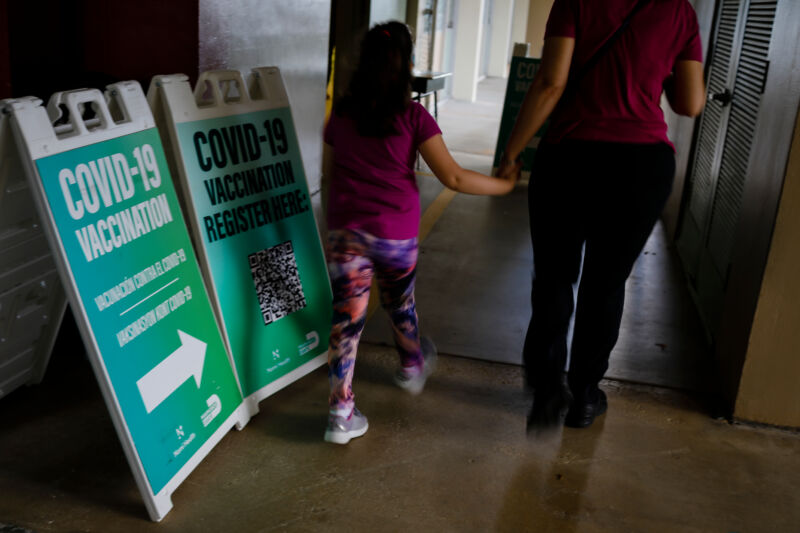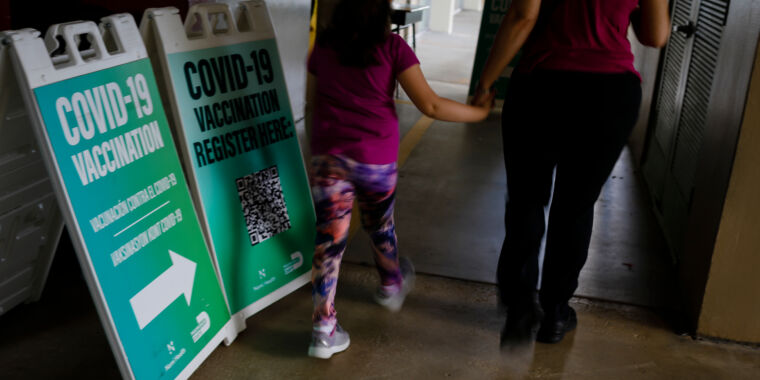
At least 75 percent of US children have now been infected with the pandemic coronavirus, up from roughly 44 percent before the omicron wave, according to a new study by the Centers for Disease Control and Prevention.
Children in the age groups of 0 to 11 and 12 to 17 have the highest infection rates and saw the most significant increases during the omicron wave compared with any other age group. About a third of all children in the country were newly infected during the omicron wave. Together, the data showcase just how poorly the country has done at shielding children—including those not yet eligible for vaccination—from the pandemic virus.
The new data dovetails with a study published by the CDC in February, which found that the peak rate of pediatric hospitalizations during the omicron wave was four times higher than the peak seen during the delta wave last fall. The largest increase was seen in children ages 0 to 4, who had a peak hospitalization rate five times higher than the peak amid delta.
Seroprevalence study
During the omicron period, the increase in infections in children was “quite striking,” Kristie Clarke, lead author of the new CDC study, said during a press briefing Tuesday. “This really reinforces some of our previous findings.”
The CDC drew data from an ongoing national survey of blood samples submitted to commercial labs for various routine and diagnostic testing for the new study. The survey included between 45,000 and 81,000 samples per four-week period between September 2021 and February 2022.
Blood samples were tested for anti-nucleocapsid (anti-N) SARS-CoV-2 antibodies, which are antibodies produced only by a SARS-CoV-2 infection, not vaccination (vaccines only produce anti-spike antibodies). The antibody test is very sensitive; it can detect low levels of anti-N antibodies for as long as one to two years after an infection. The test doesn’t reflect whether someone is protected from future protection. It simply gives a yes-or-no readout of whether someone had been infected before. To avoid biased sampling, the researchers excluded blood samples submitted specifically to test for SARS-CoV-2 antibodies. Overall, this type of surveillance study is called a seroprevalence study, which estimates the prevalence of an infection in a population based on blood samples.
Children unprotected
Clarke and colleagues focused on the period from December 2021 to February 2022 to understand the impact of the omicron wave. For the population as a whole, seroprevalence in the US rose from 33.5 percent to 58 percent. But the most significant increases in levels of infection were in children. Seroprevalence rose from 44 percent to 75 percent in children ages 0 to 11 and 46 percent to 74 percent in 12- to 17-year-olds.
In comparison, adults 18 to 49 saw seroprevalence rise from 36.5 percent to 64 percent. The 50 to 64 group had seroprevalence rates go from 29 percent to 50 percent. And those 65 and above saw seroprevalence go from 19 percent to 33 percent.
The higher seroprevalence in younger age groups reflects the relatively low vaccination rates in children—the lowest of all the age groups. While children ages 0 to 4 are not yet eligible for vaccination, children ages 5 and up are. But only 28 percent of children 5 to 11 and 59 percent of children 12 to 17 have been fully vaccinated. Children are also best protected when surrounded by adults who are up-to-date with their vaccinations. Yet, only 76 percent of adults have gotten their full primary series of vaccine doses and, of those fully vaccinated, only 46 percent have received a booster dose.
While children have a relatively lower risk of severe disease from COVID-19, they’re not immune to bad outcomes, Clarke stressed Tuesday. “In kids, COVID can certainly be quite severe,” she said, noting that among children who end up hospitalized, 20 percent to 30 percent end up in the ICU. While those tend to be children with underlying conditions, Clarke noted that 60 percent to 70 percent of COVID-related multisystem inflammatory syndrome cases in children (MIS-C) occur in previously healthy children. There’s also the risk of long COVID.
But, vaccination can protect against all of these outcomes, Clarke noted. The shots also provide broader protection than past infection, which could be critical for protecting against future variants.








